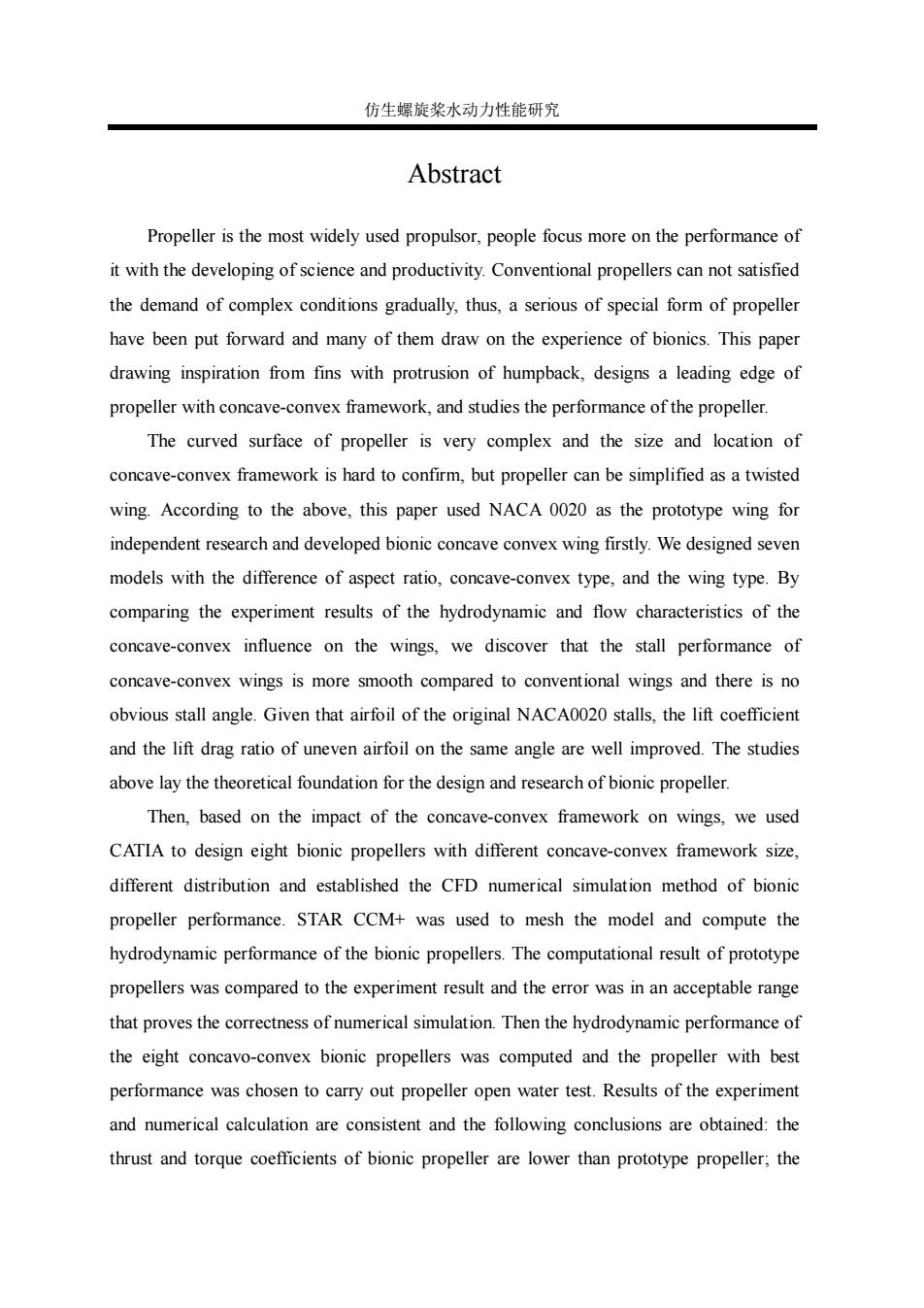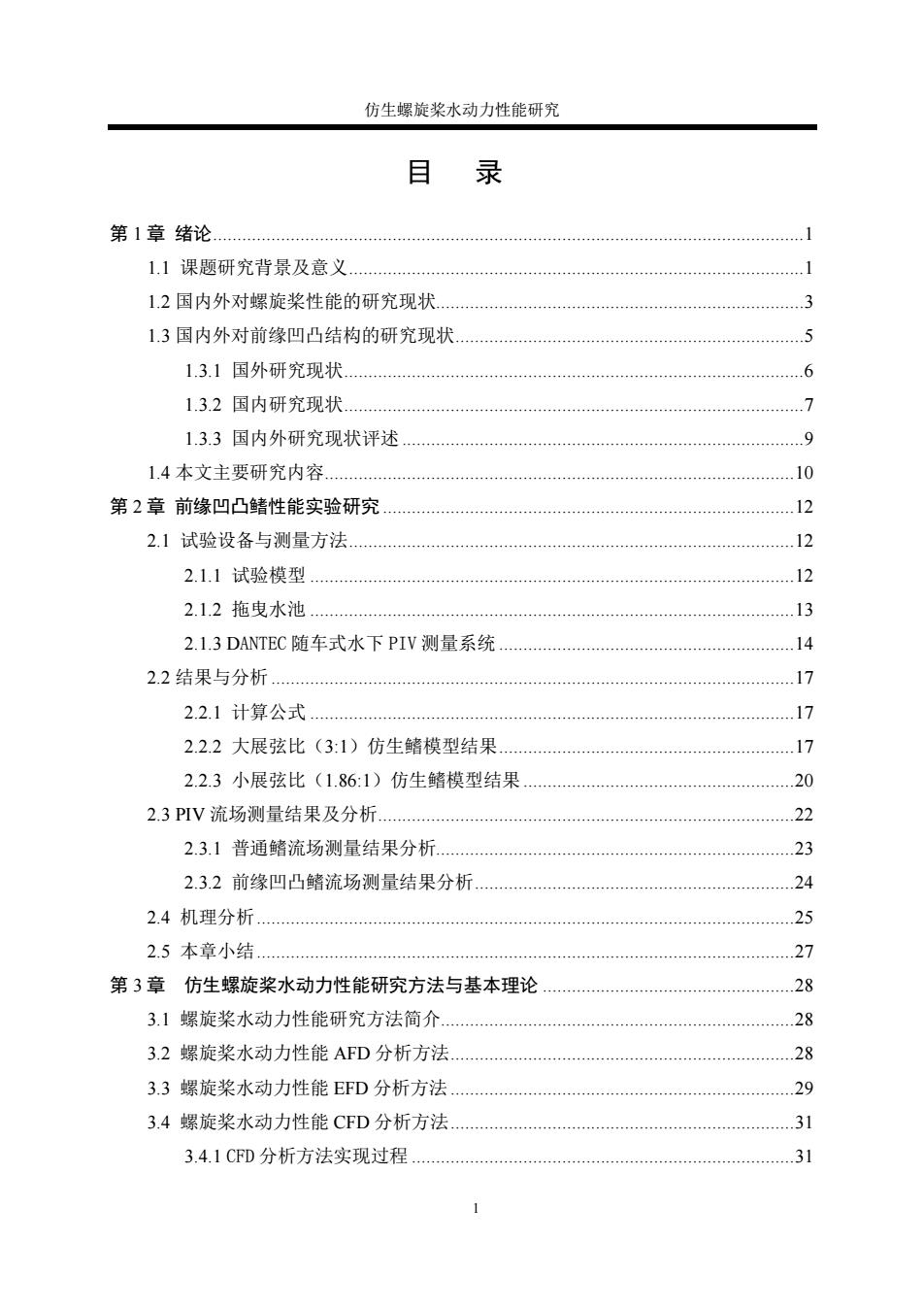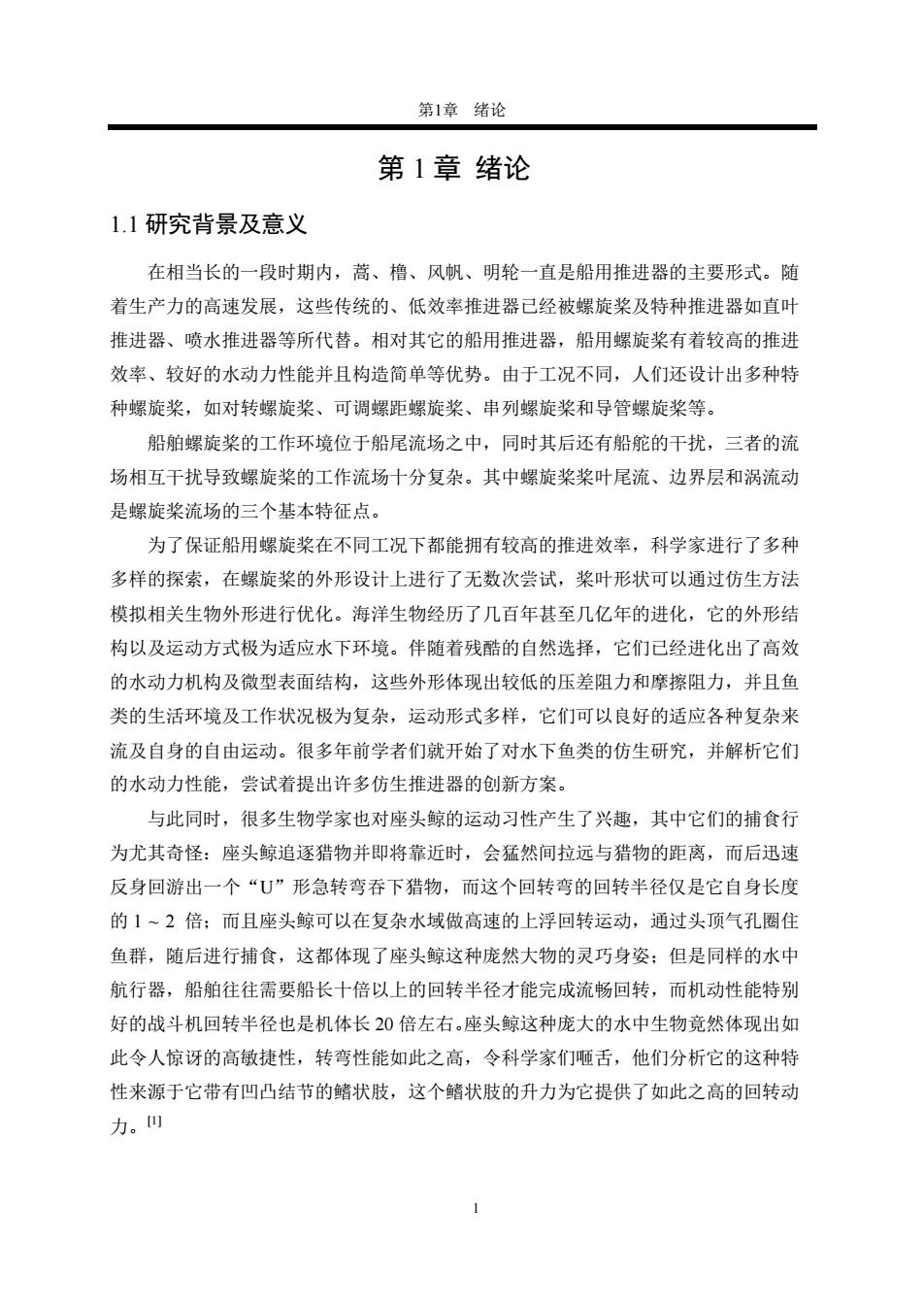
仿生螺旋桨水动力性能研究 Abstract Propeller is the most widely used propulsor,people focus more on the performance of it with the developing of science and productivity.Conventional propellers can not satisfied the demand of complex conditions gradually,thus,a serious of special form of propeller have been put forward and many of them draw on the experience of bionics.This paper drawing inspiration from fins with protrusion of humpback,designs a leading edge of propeller with concave-convex framework,and studies the performance of the propeller. The curved surface of propeller is very complex and the size and location of concave-convex framework is hard to confirm,but propeller can be simplified as a twisted wing.According to the above,this paper used NACA 0020 as the prototype wing for independent research and developed bionic concave convex wing firstly.We designed seven models with the difference of aspect ratio,concave-convex type,and the wing type.By comparing the experiment results of the hydrodynamic and flow characteristics of the concave-convex influence on the wings,we discover that the stall performance of concave-convex wings is more smooth compared to conventional wings and there is no obvious stall angle.Given that airfoil of the original NACA0020 stalls,the lift coefficient and the lift drag ratio of uneven airfoil on the same angle are well improved.The studies above lay the theoretical foundation for the design and research of bionic propeller. Then,based on the impact of the concave-convex framework on wings,we used CATIA to design eight bionic propellers with different concave-convex framework size, different distribution and established the CFD numerical simulation method of bionic propeller performance.STAR CCM+was used to mesh the model and compute the hydrodynamic performance of the bionic propellers.The computational result of prototype propellers was compared to the experiment result and the error was in an acceptable range that proves the correctness of numerical simulation.Then the hydrodynamic performance of the eight concavo-convex bionic propellers was computed and the propeller with best performance was chosen to carry out propeller open water test.Results of the experiment and numerical calculation are consistent and the following conclusions are obtained:the thrust and torque coefficients of bionic propeller are lower than prototype propeller;the
仿生螺旋桨水动力性能研究 Abstract Propeller is the most widely used propulsor, people focus more on the performance of it with the developing of science and productivity. Conventional propellers can not satisfied the demand of complex conditions gradually, thus, a serious of special form of propeller have been put forward and many of them draw on the experience of bionics. This paper drawing inspiration from fins with protrusion of humpback, designs a leading edge of propeller with concave-convex framework, and studies the performance of the propeller. The curved surface of propeller is very complex and the size and location of concave-convex framework is hard to confirm, but propeller can be simplified as a twisted wing. According to the above, this paper used NACA 0020 as the prototype wing for independent research and developed bionic concave convex wing firstly. We designed seven models with the difference of aspect ratio, concave-convex type, and the wing type. By comparing the experiment results of the hydrodynamic and flow characteristics of the concave-convex influence on the wings, we discover that the stall performance of concave-convex wings is more smooth compared to conventional wings and there is no obvious stall angle. Given that airfoil of the original NACA0020 stalls, the lift coefficient and the lift drag ratio of uneven airfoil on the same angle are well improved. The studies above lay the theoretical foundation for the design and research of bionic propeller. Then, based on the impact of the concave-convex framework on wings, we used CATIA to design eight bionic propellers with different concave-convex framework size, different distribution and established the CFD numerical simulation method of bionic propeller performance. STAR CCM+ was used to mesh the model and compute the hydrodynamic performance of the bionic propellers. The computational result of prototype propellers was compared to the experiment result and the error was in an acceptable range that proves the correctness of numerical simulation. Then the hydrodynamic performance of the eight concavo-convex bionic propellers was computed and the propeller with best performance was chosen to carry out propeller open water test. Results of the experiment and numerical calculation are consistent and the following conclusions are obtained: the thrust and torque coefficients of bionic propeller are lower than prototype propeller; the

哈尔滨工程大学硕士学位论文 open water efficiency of bionic propeller is higher than the prototype propeller when the advance coefficient is between 0.1-0.5;energy consumption and noise can be reduced due to the large decrease of blade plane vortex;vibration of the bionic propeller is lower than the prototype propeller because of a more uniform blade plane pressure. Key words:bionic propeller;concavo-convex nodules;CFD;propeller open water performance;
哈尔滨工程大学硕士学位论文 open water efficiency of bionic propeller is higher than the prototype propeller when the advance coefficient is between 0.1-0.5; energy consumption and noise can be reduced due to the large decrease of blade plane vortex; vibration of the bionic propeller is lower than the prototype propeller because of a more uniform blade plane pressure. Key words: bionic propeller; concavo-convex nodules; CFD; propeller open water performance;

仿生螺旋桨水动力性能研究 目 录 第1章绪论.… 1.1课题研究背景及意义. 1.2国内外对螺旋桨性能的研究现状 3 1.3国内外对前缘凹凸结构的研究现状 1.3.1国外研究现状. 6 1.3.2国内研究现状 .7 1.3.3国内外研究现状评述 9 1.4本文主要研究内容 10 第2章前缘凹凸鳍性能实验研究 .12 2.1试验设备与测量方法 .12 2.1.1试验模型 12 2.1.2拖曳水池 .13 2.1.3 DANTEC随车式水下PIV测量系统 .14 2.2结果与分析… 17 2.2.1计算公式 .17 2.2.2大展弦比(3:1)仿生鳍模型结果 ..17 2.2.3小展弦比(1.86:1)仿生鳍模型结果 .20 2.3PV流场测量结果及分析.… 22 2.3.1普通鳍流场测量结果分析 23 2.3.2前缘凹凸鳍流场测量结果分析 24 2.4机理分析.… 25 2.5本章小结 27 第3章仿生螺旋桨水动力性能研究方法与基本理论 28 3.1螺旋桨水动力性能研究方法简介 28 3.2螺旋桨水动力性能AFD分析方法. 28 3.3螺旋桨水动力性能EFD分析方法 29 34螺旋桨水动力性能CFD分析方法 31 3.4.1CFD分析方法实现过程 .31
仿生螺旋桨水动力性能研究 1 目 录 第 1 章 绪论..........................................................................................................................1 1.1 课题研究背景及意义..............................................................................................1 1.2 国内外对螺旋桨性能的研究现状............................................................................3 1.3 国内外对前缘凹凸结构的研究现状........................................................................5 1.3.1 国外研究现状...............................................................................................6 1.3.2 国内研究现状...............................................................................................7 1.3.3 国内外研究现状评述...................................................................................9 1.4 本文主要研究内容.................................................................................................10 第 2 章 前缘凹凸鳍性能实验研究.....................................................................................12 2.1 试验设备与测量方法............................................................................................12 2.1.1 试验模型 ....................................................................................................12 2.1.2 拖曳水池 ....................................................................................................13 2.1.3 DANTEC 随车式水下 PIV 测量系统 .............................................................14 2.2 结果与分析............................................................................................................17 2.2.1 计算公式 ....................................................................................................17 2.2.2 大展弦比(3:1)仿生鳍模型结果.............................................................17 2.2.3 小展弦比(1.86:1)仿生鳍模型结果........................................................20 2.3 PIV 流场测量结果及分析......................................................................................22 2.3.1 普通鳍流场测量结果分析..........................................................................23 2.3.2 前缘凹凸鳍流场测量结果分析..................................................................24 2.4 机理分析...............................................................................................................25 2.5 本章小结...............................................................................................................27 第 3 章 仿生螺旋桨水动力性能研究方法与基本理论 ....................................................28 3.1 螺旋桨水动力性能研究方法简介.........................................................................28 3.2 螺旋桨水动力性能 AFD 分析方法.......................................................................28 3.3 螺旋桨水动力性能 EFD 分析方法.......................................................................29 3.4 螺旋桨水动力性能 CFD 分析方法.......................................................................31 3.4.1 CFD 分析方法实现过程 ...............................................................................31

哈尔滨工程大学硕士学位论文 34.2控制方程 33 3.4.3离散方法、空间离散格式. 33 3.4.4湍流模型 33 3.45螺旋桨旋转模型 。。。。。。。。。 35 3.5本章小结 36 第4章仿生螺旋桨水动力性能数值计算及实验研究 .37 4.1螺旋桨建模概述 .37 4.1.1建模思路 37 4.1.2螺旋桨建模方法 37 4.1.3建模流程 39 4.2螺旋桨模型的建立. 39 4.2.1原型螺旋桨模型的建立 39 4.2.2仿生螺旋桨模型的建立 40 4.3CFD网格、计算域与边界条件 43 4.3.1CFD网格.… .43 4.3.2计算域与边界条件 45 4.4计算结果 46 4.5计算结果分析 49 4.5.1桨叶表面压力分析 49 4.5.2桨叶表面流线分析 50 4.5.3桨叶表面涡流场分析 52 4.6仿生螺旋桨敞水实验 .56 4.7本章小结 59 结论 .60 参考文献 62 攻读硕士学位期间发表的论文和取得的科研成果 66 致谢 … .67 2
哈尔滨工程大学硕士学位论文 2 3.4.2 控制方程 ....................................................................................................33 3.4.3 离散方法、空间离散格式..........................................................................33 3.4.4 湍流模型 ....................................................................................................33 3.4.5 螺旋桨旋转模型.........................................................................................35 3.5 本章小结...............................................................................................................36 第 4 章 仿生螺旋桨水动力性能数值计算及实验研究 ......................................................37 4.1 螺旋桨建模概述....................................................................................................37 4.1.1 建模思路 ....................................................................................................37 4.1.2 螺旋桨建模方法.......................................................................................37 4.1.3 建模流程 ....................................................................................................39 4.2 螺旋桨模型的建立................................................................................................39 4.2.1 原型螺旋桨模型的建立 .............................................................................39 4.2.2 仿生螺旋桨模型的建立 .............................................................................40 4.3 CFD 网格、计算域与边界条件.............................................................................43 4.3.1 CFD 网格 .....................................................................................................43 4.3.2 计算域与边界条件.....................................................................................45 4.4 计算结果...............................................................................................................46 4.5 计算结果分析 .......................................................................................................49 4.5.1 桨叶表面压力分析.....................................................................................49 4.5.2 桨叶表面流线分析.....................................................................................50 4.5.3 桨叶表面涡流场分析.................................................................................52 4.6 仿生螺旋桨敞水实验.............................................................................................56 4.7 本章小结................................................................................................................59 结 论 .................................................................................................................................60 参考文献 .............................................................................................................................62 攻读硕士学位期间发表的论文和取得的科研成果............................................................66 致 谢 .................................................................................................................................67

第1章绪论 第1章绪论 1.1研究背景及意义 在相当长的一段时期内,蒿、橹、风帆、明轮一直是船用推进器的主要形式。随 着生产力的高速发展,这些传统的、低效率推进器已经被螺旋桨及特种推进器如直叶 推进器、喷水推进器等所代替。相对其它的船用推进器,船用螺旋桨有着较高的推进 效率、较好的水动力性能并且构造简单等优势。由于工况不同,人们还设计出多种特 种螺旋桨,如对转螺旋桨、可调螺距螺旋桨、串列螺旋桨和导管螺旋桨等。 船舶螺旋桨的工作环境位于船尾流场之中,同时其后还有船舵的干扰,三者的流 场相互干扰导致螺旋桨的工作流场十分复杂。其中螺旋桨桨叶尾流、边界层和涡流动 是螺旋桨流场的三个基本特征点。 为了保证船用螺旋桨在不同工况下都能拥有较高的推进效率,科学家进行了多种 多样的探索,在螺旋桨的外形设计上进行了无数次尝试,桨叶形状可以通过仿生方法 模拟相关生物外形进行优化。海洋生物经历了几百年甚至几亿年的进化,它的外形结 构以及运动方式极为适应水下环境。伴随着残酷的自然选择,它们己经进化出了高效 的水动力机构及微型表面结构,这些外形体现出较低的压差阻力和摩擦阻力,并且鱼 类的生活环境及工作状况极为复杂,运动形式多样,它们可以良好的适应各种复杂来 流及自身的自由运动。很多年前学者们就开始了对水下鱼类的仿生研究,并解析它们 的水动力性能,尝试着提出许多仿生推进器的创新方案。 与此同时,很多生物学家也对座头鲸的运动习性产生了兴趣,其中它们的捕食行 为尤其奇怪:座头鲸追逐猎物并即将靠近时,会猛然间拉远与猎物的距离,而后迅速 反身回游出一个“U”形急转弯吞下猎物,而这个回转弯的回转半径仅是它自身长度 的1~2倍:而且座头鲸可以在复杂水域做高速的上浮回转运动,通过头顶气孔圈住 鱼群,随后进行捕食,这都体现了座头鲸这种庞然大物的灵巧身姿;但是同样的水中 航行器,船舶往往需要船长十倍以上的回转半径才能完成流畅回转,而机动性能特别 好的战斗机回转半径也是机体长20倍左右。座头鲸这种庞大的水中生物竟然体现出如 此令人惊讶的高敏捷性,转弯性能如此之高,令科学家们咂舌,他们分析它的这种特 性来源于它带有凹凸结节的鳍状肢,这个鳍状肢的升力为它提供了如此之高的回转动 力。山
第1章 绪论 1 第 1 章 绪论 1.1 研究背景及意义 在相当长的一段时期内,蒿、橹、风帆、明轮一直是船用推进器的主要形式。随 着生产力的高速发展,这些传统的、低效率推进器已经被螺旋桨及特种推进器如直叶 推进器、喷水推进器等所代替。相对其它的船用推进器,船用螺旋桨有着较高的推进 效率、较好的水动力性能并且构造简单等优势。由于工况不同,人们还设计出多种特 种螺旋桨,如对转螺旋桨、可调螺距螺旋桨、串列螺旋桨和导管螺旋桨等。 船舶螺旋桨的工作环境位于船尾流场之中,同时其后还有船舵的干扰,三者的流 场相互干扰导致螺旋桨的工作流场十分复杂。其中螺旋桨桨叶尾流、边界层和涡流动 是螺旋桨流场的三个基本特征点。 为了保证船用螺旋桨在不同工况下都能拥有较高的推进效率,科学家进行了多种 多样的探索,在螺旋桨的外形设计上进行了无数次尝试,桨叶形状可以通过仿生方法 模拟相关生物外形进行优化。海洋生物经历了几百年甚至几亿年的进化,它的外形结 构以及运动方式极为适应水下环境。伴随着残酷的自然选择,它们已经进化出了高效 的水动力机构及微型表面结构,这些外形体现出较低的压差阻力和摩擦阻力,并且鱼 类的生活环境及工作状况极为复杂,运动形式多样,它们可以良好的适应各种复杂来 流及自身的自由运动。很多年前学者们就开始了对水下鱼类的仿生研究,并解析它们 的水动力性能,尝试着提出许多仿生推进器的创新方案。 与此同时,很多生物学家也对座头鲸的运动习性产生了兴趣,其中它们的捕食行 为尤其奇怪:座头鲸追逐猎物并即将靠近时,会猛然间拉远与猎物的距离,而后迅速 反身回游出一个“U”形急转弯吞下猎物,而这个回转弯的回转半径仅是它自身长度 的 1 ~ 2 倍;而且座头鲸可以在复杂水域做高速的上浮回转运动,通过头顶气孔圈住 鱼群,随后进行捕食,这都体现了座头鲸这种庞然大物的灵巧身姿;但是同样的水中 航行器,船舶往往需要船长十倍以上的回转半径才能完成流畅回转,而机动性能特别 好的战斗机回转半径也是机体长 20 倍左右。座头鲸这种庞大的水中生物竟然体现出如 此令人惊讶的高敏捷性,转弯性能如此之高,令科学家们咂舌,他们分析它的这种特 性来源于它带有凹凸结节的鳍状肢,这个鳍状肢的升力为它提供了如此之高的回转动 力。[1]